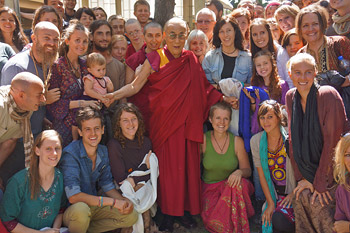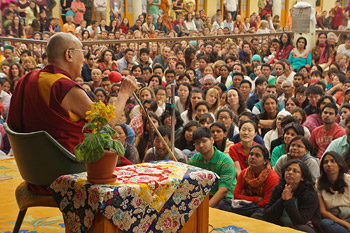Dharamsala, HP, India, 28 May 2014 - It was comfortably warm in McLeod Ganj today when His Holiness the Dalai Lama gave the second public audience in recent weeks, attended by approximately 1500 people from 62 countries, including 300 Indians. His Holiness walked from his office down to the Tsuglagkhang courtyard where people had been organized in national or regional groups. He posed for photographs, shook hands and exchanged greetings with the many well-wishers.

|
His Holiness the Dalai Lama posing for a photo with some of the 1500 people attending his public audience in Dharamsala, HP, India on May 28, 2014. Photo/Jeremy Russell/OHHDL
|
Once photographs had been taken he went up into the Tsuglagkhang to pay his respects while the crowd rearranged themselves to be ready to listen to him. He began by saying that he had recently decided to revive his custom of periodically meeting with the public and visitors to Dharamsala.
“We are all the same,” he said, “physically, mentally and emotionally. We all want to lead a happy life and we have a right to do so.”
He spoke about how in a materialistic world many people depend on sensory experiences to be happy, but that such experiences are short-lived. He said that developing inner peace is more effective. Conceding that we are all driven by self-interest he said:
“The key is to follow self-interest wisely by developing concern for others rather than foolishly being only concerned for ourselves.”

|
His Holiness the Dalai Lama speaking to over 1500 foreigners and Indians attending his public audience in Dharamsala, HP, India on May 28, 2014. Photo/Jeremy Russell/OHHDL
|
In the Tibetan Buddhist tradition the knowledge involved in such mental training derives from the traditions that flourished at Nalanda University in India. He expressed gratitude to the ancient Indians who he regards as Tibet’s gurus, while urging contemporary Indians to keep up their longstanding practice of ahimsa, non-violence and the remarkable inter-religious harmony that derives from a respectful secular approach to spiritual traditions.
When answering several questions from the audience he affirmed that no matter how troublesome the world around us may be, it is always wiser to resolve conflict through non-violence and dialogue. Asked how friends can support Tibetans he said the Tibetan cause is a just cause, so to support it is to support justice. He said he sometimes characterizes the situation as a struggle between the power of the gun and the power of truth. In the short term, the gun seems stronger and more effective, but in the long term it is the power of truth that prevails. He expressed optimism that the present younger generation, who belong to the 21st century, will be able to shape a happier, more peaceful world. 